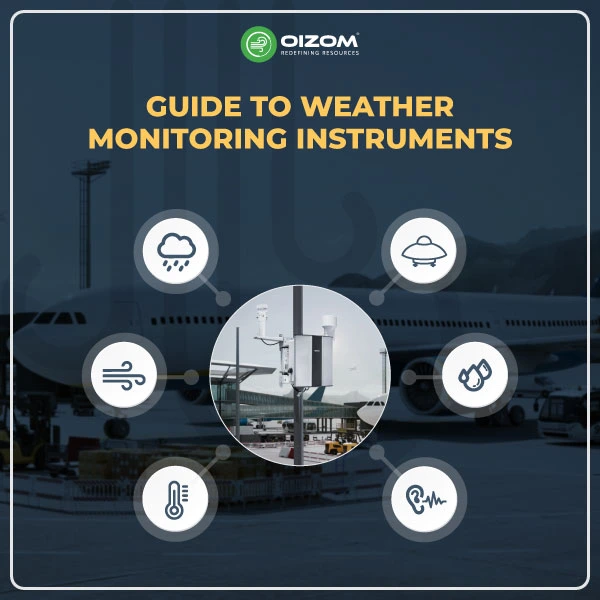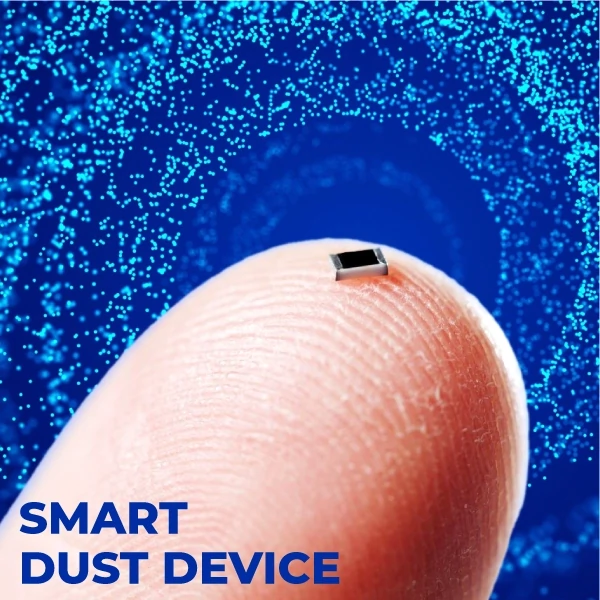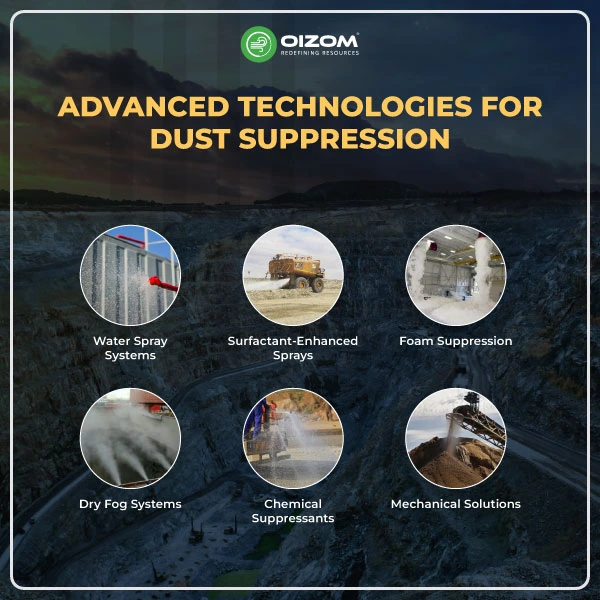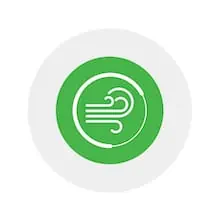TL: DR
Ever wondered how weather forecasts know what’s coming? It’s thanks to clever tools that measure everything from temperature and humidity to wind and rainfall. Simple instruments like thermometers and barometers work alongside high-tech sensors like radar, LIDAR, and satellites to give accurate, real-time weather data.
These instruments aren’t just useful, they’re essential. Farmers rely on them for smarter crop management, pilots use them for safe flights, and cities depend on them to plan infrastructure and manage disasters. Compact systems, such as Oizom’s Weathercom, combine multiple sensors into one robust device, making it easy to gather reliable data even in tough conditions.
When choosing weather instruments, accuracy, durability, and connectivity matter most. Modern systems integrate seamlessly with IoT platforms, offering instant data access from anywhere. As climate change continues to affect our daily lives, having accurate, connected, and durable weather instruments isn’t just about understanding the weather, it’s about staying safe and prepared for the future.
Guide to Weather Monitoring Instruments
Have you ever looked at a weather forecast and wondered how they actually measure all those details, like wind speed, humidity, or air pressure? It’s not magic; it’s the science of weather monitoring, powered by some pretty smart instruments.
From the simple thermometer to high-tech weather sensors, each instrument has a specific job. Together, they paint a full picture of what’s happening in the atmosphere, whether it’s predicting a thunderstorm, tracking climate patterns, or ensuring safety in industries and agriculture.
In this blog, we’ll walk you through the key weather monitoring instruments used today. We’ll break down what they do, how they work, and where you’ll typically find them, whether on a school rooftop, a remote weather station, or an industrial site.
Whether you’re a weather enthusiast, a student, or a professional looking to understand the tools behind accurate weather data, this guide is for you. Let’s dive into the world of weather instruments and discover how they help us stay one step ahead of nature.
Types of Weather Observation Instruments
Most weather forecasts you see on TV or online come from a weather station at a fixed spot, often at places like airports. But if you live far from that location, the actual weather around you might be quite different. That’s where compact weather instruments come in, and they give you accurate, real-time weather updates right where you are.
Basic weather tools like thermometers are part of our daily lives. However, there are also advanced instruments, like pyranometers and disdrometers, that, while less known, offer great value for both individuals and businesses. However, buying each weather tool separately can be expensive and take up space. A better option is an all-in-one weather device like the Oizom Weathercom, which combines multiple sensors into one compact system. Below, we will discuss the types of weather instruments.
Types of Weather Instruments
Weather instruments are mainly divided into two groups:
- Ground-based instruments that measure conditions near the Earth’s surface.
- High-altitude instruments gather data from higher levels in the atmosphere.
Together, these tools help us understand the full picture of the weather around us.
Common Weather Instruments and Their Uses
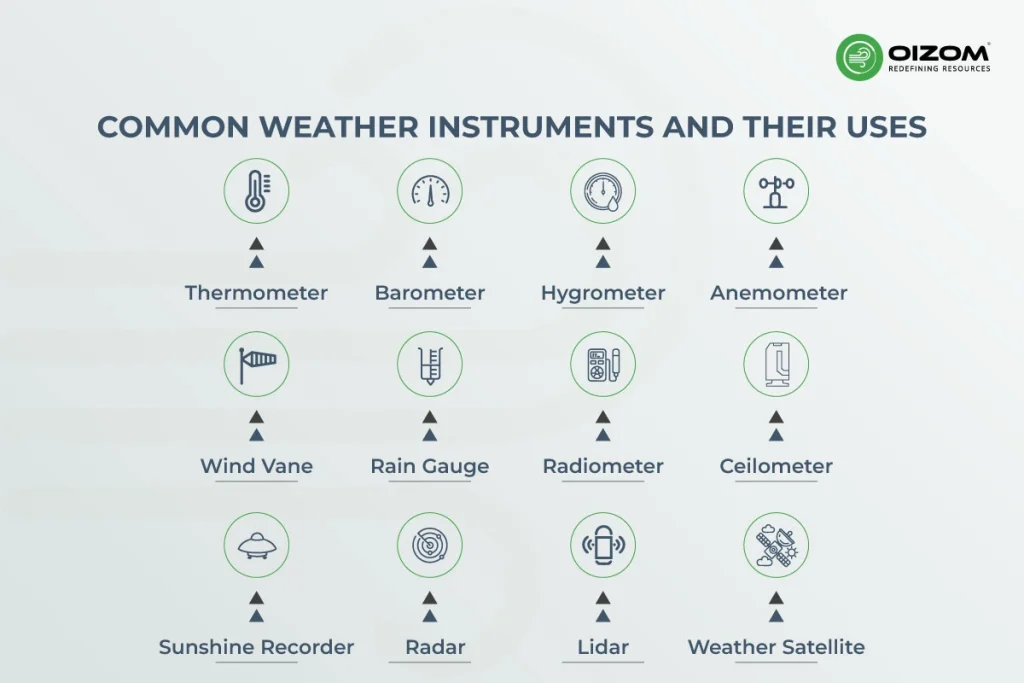
- Thermometer
Used to measure temperature, thermometers are key to any weather observation. Today’s weather stations use advanced types like resistance thermometers or semiconductor thermometers, which are more accurate than traditional mercury ones. These readings support climate research, agriculture, aviation, and environmental studies. - Barometer
This tool measures air pressure, helping us predict weather changes like storms or wind shifts. While older barometers use mercury, modern ones are digital and give more precise readings. Barometric data is useful for forecasting, flying, and hiking. - Hygrometer
Hygrometers measure humidity, or the amount of moisture in the air. From preventing mold in storage to helping with smart irrigation in agriculture, hygrometers have wide applications today. - Anemometer
Anemometers measure wind speed. Types like ultrasonic or cup-style anemometers are common in weather stations. They’re useful for flight safety, pollution tracking, and even wind energy design. - Wind Vane
Wind vanes show the direction the wind is blowing. Modern electronic versions offer higher accuracy and are often paired with anemometers to give a complete view of wind behavior. They’re helpful in farming, navigation, and urban planning. - Rain Gauge
Rain gauges collect and measure rainfall. Basic ones require manual reading, while tipping-bucket models automatically record data. They’re essential for flood warnings, farming decisions, and drainage system planning. - Sunshine Recorder
These devices measure sunlight intensity and duration. Older versions used burning paper strips, while today’s digital ones rely on photodiodes. Sunshine data helps predict climate changes and manage farming cycles. - Radiometer
Radiometers measure solar radiation, from UV to infrared. They help study the Earth’s energy balance, greenhouse gases, and even radiation from celestial objects. - Ceilometer
This instrument measures cloud height and thickness using lasers or light sensors. It’s mostly used in aviation, climate research, and weather forecasting. - Radar
Weather radar uses radio waves to detect clouds, rain, and storms. Doppler radar even tracks how fast weather systems move. It’s crucial for aviation safety and severe weather alerts. - Lidar
Lidar uses laser light to scan the atmosphere and map objects in 3D. It’s widely used in environmental monitoring, city planning, and self-driving technology. - Weather Satellite
Orbiting the Earth, these satellites collect large-scale data on clouds, temperature, rainfall, and more. They’re essential for tracking extreme weather and natural disasters like hurricanes, wildfires, and floods.
Weather Instrument Comparison Table
| Instrument | Measures | Application Example | Accuracy Level | Cost Level |
|---|---|---|---|---|
| Thermometer | Temperature | Agriculture, Aviation | High (RTD, semiconductor) | Low–Medium |
| Barometer | Atmospheric Pressure | Weather Forecasting, Aviation | Very High (Digital) | Medium |
| Hygrometer | Humidity | Storage, Agriculture | High (Digital) | Medium |
| Anemometer | Wind Speed | Renewable Energy, Aviation | Very High (Ultrasonic) | Medium–High |
| Wind Vane | Wind Direction | Farming, Navigation | High (Electronic) | Medium |
| Rain Gauge | Rainfall | Flood Warnings, Agriculture | High (Tipping-bucket) | Low–Medium |
| Sunshine Recorder | Sunlight Intensity | Climate Studies, Agriculture | Medium–High (Digital) | Medium |
| Radiometer | Solar Radiation | Climate Research, Astronomy | High (Digital) | High |
| Ceilometer | Cloud Height | Aviation, Climate Research | Very High (Laser-based) | High |
| Radar | Rain, Storms | Weather Alerts, Aviation | Very High (Doppler) | High |
| Lidar | Atmospheric Mapping | Environmental Monitoring, City Planning | Very High (Laser-based) | High |
| Weather Satellite | Large-scale Weather Patterns | Disaster Tracking, Climate Studies | Very High (Satellite Imaging) | Very High |
Applications of Weather Observation Instruments
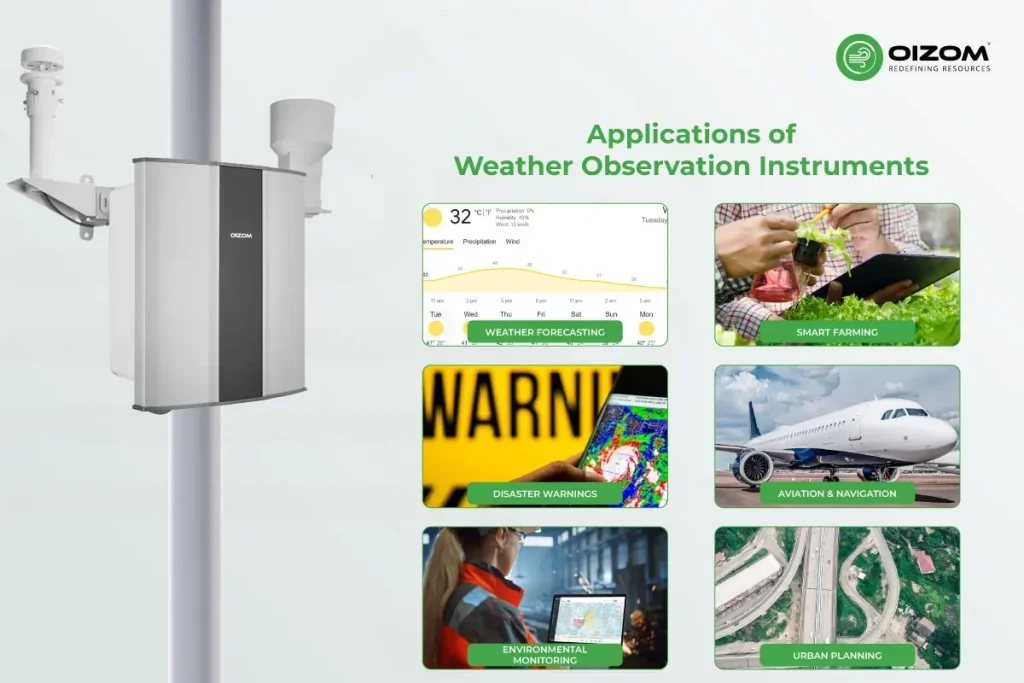
Weather observation instruments do more than just track the rain or solar radiation, they provide critical data that supports a wide range of real-world applications. From forecasting daily weather to managing disasters, agriculture, aviation, and city planning, these tools help us make smarter, safer, and more informed decisions.
Did you know? The market for weather monitoring solutions and services is growing fast! It jumped from $1.58 billion in 2024 to $1.7 billion in 2025, growing at a steady rate of 7.7% per year.
- Weather Forecasting: Tools like hygrometers, barometers, and anemometers collect real-time data that helps predict short-term weather changes, like rain, storms, or heatwaves. Over time, this data can also spot long-term patterns, including global events like El Niño or climate shifts.
- Disaster Warnings: Weather instruments play a big role in early warning systems. For example, rising water levels can signal floods, while satellites track severe storms like hurricanes and typhoons. With timely alerts, communities can act fast and reduce damage. A real-world example is Diu Smart City, where advanced environmental monitors like Oizom’s Polludrone have been deployed to track air quality and weather parameters. This kind of real-time data helps the city respond quickly to potential risks, supporting safer and more sustainable urban living.
Curious to know how Diu is using smart monitoring for a better future? Read the full case study here.
- Environmental Monitoring: Anemometers and air quality sensors help track pollutants such as PM2.5, ozone, and sulfur dioxide. This data supports environmental agencies in taking informed action to improve air quality.
- Smart Farming: Installing weather tools in farms gives farmers real-time updates on temperature, rainfall, sunlight, and soil conditions. This helps them choose the right crops, plan irrigation, and boost crop health and yield.
- Aviation & Navigation: Accurate weather data is essential for flight and shipping safety. Real-time monitoring from weather stations and satellites helps planes and ships avoid rough weather and stay on course.
- Urban Planning: Weather data supports better city planning by identifying safer, more suitable locations for building and infrastructure. It also helps design smarter transportation systems and avoid disaster-prone areas.
How to Choose the Right Weather Observation Instruments?
Choosing the right weather instruments isn’t just about picking gadgets. It’s about selecting tools that suit your specific monitoring needs and environmental conditions.
Start with your purpose. Are you measuring weather for agricultural planning, environmental research, disaster alerts, or urban planning? For example, if you’re focused on farming, you’ll need reliable thermometers, rain gauges, hygrometers, and soil sensors. If you’re monitoring urban air quality, instruments like anemometers, wind vanes, and PM sensors become essential.
Accuracy and range matter. Look for instruments that meet industry standards for precision. For instance, a platinum resistance thermometer (RTD) may be ideal for highly accurate temperature readings, while a digital barometer with fine resolution is key for pressure tracking.
Consider your environment. Extreme outdoor conditions demand durable instruments, go for weatherproof, corrosion-resistant devices with built-in calibration systems. Solid-state or thermistor-based sensors are popular for their durability and low power consumption. Devices like Oizom’s Weathercom are designed exactly for such environments, featuring an IP66-certified enclosure that stands strong against dust, rain, and harsh weather, ensuring reliable performance, no matter the conditions.
Think integration. If you’re setting up a full weather station, opt for devices that can be networked via protocols like RS-485, Modbus, or IoT platforms for seamless data transmission. This ensures your instruments talk to each other and feed data into a centralized platform for real-time analysis.
Lastly, balance cost vs. value. While multi-parameter systems like Oizom’s Weathercom may cost more upfront, they often provide better scalability, remote access, and maintenance ease, making them a smarter long-term investment.
Benefits of weather observation instrument
Weather observation instruments aren’t just helpful, they’re essential for collecting accurate and real-time data about the environment. From basic tools like thermometers to advanced weather stations, each device plays an important role in understanding what’s happening in the atmosphere.
One big benefit is accuracy. Tools like RTD thermometers, digital barometers, and ultrasonic anemometers give precise readings of temperature, pressure, and wind speed. This kind of reliable data is especially useful in industries like aviation, farming, and research, where even small changes can make a big difference.
Another major advantage is real-time monitoring. Many modern instruments can send data instantly through IoT platforms, helping people respond quickly to changing weather, like sudden storms or heatwaves.
Weather instruments also help with forecasting. By tracking weather over time, they can identify patterns and trends, which is useful for long-term planning in cities, agriculture, and climate studies. Plus, today’s devices are made to last. Many come with weatherproof enclosures (such as IP66-rated protection) and need very little maintenance. They’re built to handle rain, dust, and tough outdoor conditions without compromising performance.
In short, weather observation instruments give us the tools to make smarter, faster decisions, keeping people safe, protecting the environment, and supporting a range of industries.
Conclusion
Weather monitoring instruments are the backbone of accurate forecasting and climate understanding. From thermometers that track temperature to advanced sensors like LIDAR and radiometers, each instrument serves a specific purpose in collecting real-time environmental data. Their precision and reliability help industries, researchers, and governments make data-driven decisions every day.
Today’s instruments are becoming smarter, integrating with IoT platforms, using low-power components, and offering remote data access. Devices like anemometers, barometers, and ceilometers are no longer standalone tools; they’re part of interconnected systems feeding continuous data into automated control platforms.
Looking ahead, the future of weather monitoring lies in AI-powered analysis, edge computing, and even satellite-to-ground integration, enabling faster responses and predictive insights. This evolution will be crucial for building climate-resilient infrastructure, improving disaster preparedness, and managing resources efficiently.
Choosing the right instruments now isn’t just about meeting current needs, it’s about aligning with the broader objectives of weather monitoring system—from enhancing public safety to supporting sustainable development. As the climate continues to change, having accurate, durable, and connected weather tools will be more important than ever.

